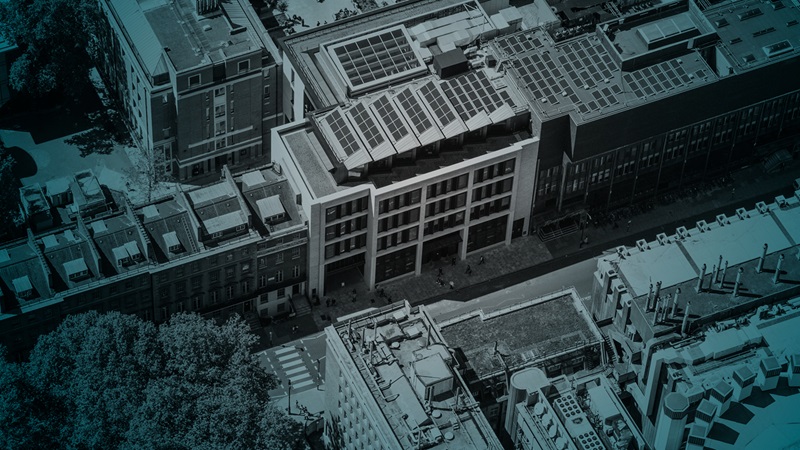One chance to build a better future
Construction is being heralded as the cornerstone to the world’s economic recovery. With the industry making significant contributions to economic output each year, the sector has the opportunity to lead the way in rebuilding countries by delivering much needed social infrastructure and securing high levels of employment over the next decade.
However, with opportunity comes responsibility. As a major contributor to carbon emissions the sector must continue to challenge, innovate and transform so that recovery from the Covid-19 pandemic builds a better future and doesn’t come at the cost of an alternative global crisis.
Climate emissions, despite a dip in recent months, continue to rise. The industry must recognise the part it will need to play in lowering carbon emissions while spearheading economic recovery.
The industry now needs recovery plans that deliver both economic recovery from the pandemic and build on decarbonisation commitments with learning from the past few months. Systemic change is needed for new buildings to be developed sustainably and existing buildings to be effectively decarbonised so that people can live, work and socialise responsibly.
1. A loud call for low carbon
Latest government announcements build on the growing evidence that the pandemic has provided an opportunity for the world to unite in building a better future, specifically by developing green recovery plans that decarbonise our future.
Over the last few months, hundreds of top firms and investors have called for Covid-19 recovery plans that place the environment at their centre – and governments have been listening.
Germany set the bar with an announced plan for a €130bn stimulus package that includes a minimum of €40bn climate-related spending, while the UK and Chile have co-launched ‘Race to Zero’ – a global campaign to drive businesses and nations to unite behind a green global recovery.
Economic research carried out by Oxford University suggests that mobilising significant fiscal spend on climate-friendly green policy initiatives could “not only help shift the world closer to a net-zero emissions pathway, but could also offer the best economic returns for government spending”. The study, which collated the views of 230 leading economists, highlighted five policy matters that are believed to drive the greatest impact:
- Clean physical infrastructure investment in the form of renewable energy assets, storage (including hydrogen), grid modernisation and carbon capture and storage (CCS) technology;
- Building efficiency spending for renovations and retrofits including improved insulation, heating and domestic energy storage systems;
- Investment in education and training to address immediate unemployment from Covid-19 and structural shifts from decarbonisation;
- Natural capital investment for ecosystem resilience and regeneration including restoration of carbon-rich habitats and climate-friendly agriculture;
- Clean research and development spending;
2. Industry action
The UK construction industry has been clear what action it needs to take to support the country’s economic recovery responsibly. On 1st June 2020 the Construction Leadership Council published its ‘Roadmap to Recovery’, which proposes a range of smart measures towards improving the sustainability and resource efficiency of the construction sector, and making measurable progress towards delivering net zero carbon (NZC).
In a recent poll of global construction industry experts, 68% stated that Covid-19 has actually given them the opportunity to accelerate carbon plans or put it high on the agenda. Reassuringly, no one reported that carbon commitments had dropped off the agenda.
The biggest challenges affecting net zero carbon commitments in the built environment are reportedly:
- Competing priorities without an understanding of the longer-term returns on investment from green initiatives.
- Lack of engagement in research and development – supporting mobilisation from the lab and into delivery.
- Understanding of how to set achievable targets and measure outcomes.
- Scale of complexity – typically capturing data from portfolios across multiple locations.
- Reducing scope 3 emissions.
The challenge of addressing scope 3 emissions presents the biggest opportunity for innovative solutions. As businesses develop recovery plans it is expected that, with a changed landscape and renewed focus, companies will tackle scope 3 head on, particularly around business travel, commuting and the increased use of sustainable materials.
| Scope | Definition | Example |
| 1 |
All direct emissions from activities of an organisation or under their control. Including fuel combustion on site such as gas boilers, fleet vehicles and air-conditioning leaks. |
Fuel use Company vehicles |
| 2 |
Indirect emissions from electricity purchased and used by the |
Purchased energy use |
| 3 | All other indirect emissions in an organisation's value chain. For many organisations the majority of emissions lie outside their own operations. |
Purchased goods and services Business travel |
The responsibility for success sits across the entire sector. For the industry to collectively embrace bold change, clients must fully consider and embrace ambitious carbon reduction strategies when setting the outcomes they want to achieve for their programmes and projects.
3. Learning - from one crisis to another
What is encouraging is the alignment and engagement to transform. There is fresh appetite for change which appears to build on the momentum of ambitious commitments made at the beginning of 2020.
It could be argued that Covid-19 has broken down barriers that previously held action back. What the pandemic has proven to the world is that we can rapidly change behaviour and live differently, and in many ways our lives are richer as a result.
We have had our eyes opened to the fragility of society and have learnt that governments and companies will put humanity first. And we have experienced, for the first time, how powerful the world can be when it works together against a common enemy.
4. Addressing two sides of the coin
While the call for a green recovery is being answered, the emerging response is predominately focused on getting new buildings right.
However, there is a flip side that must not be ignored. The major opportunity to reduce carbon emissions from the built environment is within existing buildings. Many private sector companies, particularly in the retail and financial sectors, have been successfully reducing their operational carbon through retrofitting and estate rationalisation and optimisation but with many organisations yet to follow suit, the surface has merely been scratched.
Take the education sector, for example. There are 24,000 schools in the UK, collectively spending a total of around £2bn each year on repairs and maintenance.
By diverting 10% of that spend to low carbon retrofit, over four years 8,000 schools could reduce their carbon emissions by up to 50% - delivering huge carbon and operational cost savings, not to mention the reduced impact on the environment, and is estimated to pay back within just three years.
5. A radical solution to NZC social infrastructure
The key to truly addressing the challenge of carbon emissions associated with the built environment is to take a fully integrated approach to both new build and the retrofitting of existing buildings.
An integrated system typically brings together modern methods of construction with a nation-wide hub and spoke strategy that, not only reduces carbon emissions but reduces costs and delivery time, raises standards, and generates and sustains local employment.
Importantly this model responds directly to the Government’s ambition to ‘level up the UK’, by generating social value at the point of delivery and from the outset – an important point echoed by many country leaders.
6. The common corporate challenge
Covid-19 will, without doubt, impact corporate carbon reduction efforts. From integrating new commitments into business recovery plans to changing how it is recorded to account for new business practices. However, a recent industry webinar discussion, hosted by Mace, highlighted the common challenges that are likely to prevent this unique opportunity from being fully realised.
- Corporate engagement In a recent poll, 75% of global industry professionals said their c-suite was engaged in developing recovery plans around low carbon initiatives. Despite this encouraging commitment, the challenge that remains is the execution. Almost half the companies reported that the mechanisms to cascade these large corporate targets into business decision are yet to be defined.
- Bite size targets The most common date for businesses to become net zero carbon is 2030, with many still working towards 2040 and even 2050 dates. Future ambitious targets are absolutely required but the challenge is creating momentum behind targets that sit so far on the horizon. People want targets that they can personally affect, and now. Creating priority work-streams that support the breakdown of bold corporate targets is imperative to engaging and involving workforces.
- Power to the people Companies cannot achieve carbon reduction alone through corporate initiatives - the power lies in the workforce to deliver against them. People are hungry to support responsible business ambitions but they need a platform that supports their integration and gives them a voice to make change happen. Incentivisation and internal fund schemes are a growing trend in empowering employees to get involved.
- Embrace the innovation The technology to support us isn’t new but the attitude is. With new ambition and readiness, we must embrace the wealth of technology that exists and engage with future research and development. Better support will reduce costs through economies of scale and drive demand for improved solutions.
7. Achieving net zero carbon in 2020
For the last eight years Mace has invested heavily in reducing its impact on the planet but, as an industry leader, we believe we have the responsibility to spearhead positive change, introduce best practice throughout our global networks and encourage collaborative action across our sector.
In January, Mace made a bold commitment to become a net zero carbon business in 2020 and subsequently made our strategy ‘Steps without footprints’ publicly available. Mace has additionally made the following commitments to the Department for Environment, Food and Rural Affairs as part of COP26:
PRACTICAL ACTIONS TO REDUCE GREENHOUSE GAS EMISSIONS
- Measure our Scope 1, 2 and 3 emissions.
- Commit to making our organisation a Net-Zero GHG Emissions business by end 2030.
- Make our Board accountable for our GHG emissions and aware of the risk it poses to our company and the planet.
- Commit to buying 100% renewable electricity from our supplier by 2025 and join RE100.
- Commit to buying 100% renewable energy by 2030.
NATURE AND BIODIVERSITY ACTIONS FOR BUSINESSES
- Commit to a 2030 biodiversity net gain target (by end 2020).
- By end 2020 identify the harmful direct impacts and dependencies our business has on nature and biodiversity and set targets for reducing them.
- By end 2020 set targets for restoring nature and biodiversity through our business and supply chain.
- By end 2020 commit to restoring a specified number of hectares of land within DEFRA’s Nature Recovery Network over the next 10 years.
- Commit to publishing the results of our work.














